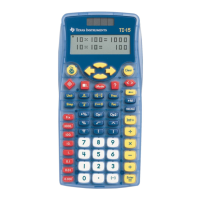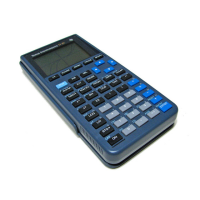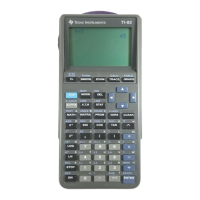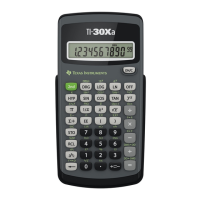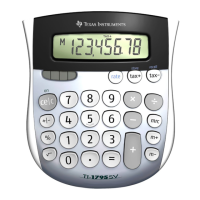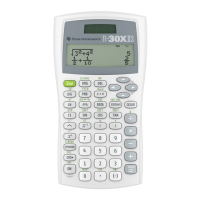Do you have a question about the Texas Instruments TI-68 and is the answer not in the manual?
The display uses letters, numbers, and symbols for calculation entries and status.
Perform calculations with complex numbers naturally and straightforwardly.
Recall, check, and edit the last calculated equation.
Calculator includes combinations, permutations, and metric conversions.
Use meaningful abbreviations for variables and formulas.
Find real and complex roots of polynomials up to fourth order.
Perform calculations in hexadecimal, octal, and binary number bases.
Retains stored entries even when the calculator is turned off.
Adjust settings like angle units, number base, and precision.
Recall, check, and edit the last calculated equation.
Explains how to power the calculator on and off.
Details the entry line, character display, and indicator symbols.
Describes how to adjust settings like angle units and number base.
Details how to set and use the fixed decimal format for results.
Learn to enter numbers, including symbols, and how the calculator interprets them.
Understand entry length, terms like 'equation' and 'formula', and their limits.
Explains the EOS for entering expressions and order of operations.
Learn to correct mistakes before or after calculation by editing entries.
An alphabetical listing of scientific functions with comments and examples.
Details on specific functions like DMS and angle conversions.
Explains the format and conversion of degrees/minutes/seconds (DMS) numbers.
Details how to convert between degrees, radians, and grads.
Learn to enter complex numbers in rectangular and polar forms.
Perform calculations using complex numbers with various mathematical functions.
Defines real and imaginary parts, magnitude and angle for complex numbers.
Step-by-step guide to entering complex numbers as (real, imaginary).
Assign values to variables for later recall and use in calculations.
Recall stored numbers from variables into the entry line.
Combine arithmetic and logic functions with stored variables.
Use the variable routine to define, review, and delete variables.
Enables saving expressions for repeated use with formula storage.
Routine to store, evaluate, and integrate formulas.
Evaluate a formula for multiple values of a variable efficiently.
Use the result of one formula as input for another.
Defines conventions for writing simultaneous equations in rows and columns.
Step-by-step guide to solving systems of simultaneous equations.
Applies simultaneous equations to solve a circuit analysis problem.
Uses simultaneous equations to analyze an impedance network.
Defines coefficients and roots for polynomials.
Step-by-step guide to finding polynomial roots.
Demonstrates finding roots for a fourth-order polynomial.
Shows how to find all fourth roots of a negative number.
Explains how to designate decimal, hexadecimal, octal, or binary bases.
Guides on converting numbers between different bases.
Introduces two's complement and 'not' functions for binary numbers.
Perform arithmetic operations using numbers from different bases.
Overview of the three-step procedure for solving statistics problems.
Guides on entering and removing data points for statistical analysis.
How to view and interpret results from one-variable and two-variable statistics.
Perform linear regression to find relationships between two variables.
Lists main syntax forms, functions, and syntax reminders.
Details common error messages and their causes.
Provides input and output ranges for various calculator functions.
Details the type of battery used and how to replace it.
Provides solutions for common operating difficulties.
Contact information for product support and service.
Outlines the one-year limited warranty, coverage, and disclaimers.
The display uses letters, numbers, and symbols for calculation entries and status.
Perform calculations with complex numbers naturally and straightforwardly.
Recall, check, and edit the last calculated equation.
Calculator includes combinations, permutations, and metric conversions.
Use meaningful abbreviations for variables and formulas.
Find real and complex roots of polynomials up to fourth order.
Perform calculations in hexadecimal, octal, and binary number bases.
Retains stored entries even when the calculator is turned off.
Adjust settings like angle units, number base, and precision.
Recall, check, and edit the last calculated equation.
Explains how to power the calculator on and off.
Details the entry line, character display, and indicator symbols.
Describes how to adjust settings like angle units and number base.
Details how to set and use the fixed decimal format for results.
Learn to enter numbers, including symbols, and how the calculator interprets them.
Understand entry length, terms like 'equation' and 'formula', and their limits.
Explains the EOS for entering expressions and order of operations.
Learn to correct mistakes before or after calculation by editing entries.
An alphabetical listing of scientific functions with comments and examples.
Details on specific functions like DMS and angle conversions.
Explains the format and conversion of degrees/minutes/seconds (DMS) numbers.
Details how to convert between degrees, radians, and grads.
Learn to enter complex numbers in rectangular and polar forms.
Perform calculations using complex numbers with various mathematical functions.
Defines real and imaginary parts, magnitude and angle for complex numbers.
Step-by-step guide to entering complex numbers as (real, imaginary).
Assign values to variables for later recall and use in calculations.
Recall stored numbers from variables into the entry line.
Combine arithmetic and logic functions with stored variables.
Use the variable routine to define, review, and delete variables.
Enables saving expressions for repeated use with formula storage.
Routine to store, evaluate, and integrate formulas.
Evaluate a formula for multiple values of a variable efficiently.
Use the result of one formula as input for another.
Defines conventions for writing simultaneous equations in rows and columns.
Step-by-step guide to solving systems of simultaneous equations.
Applies simultaneous equations to solve a circuit analysis problem.
Uses simultaneous equations to analyze an impedance network.
Defines coefficients and roots for polynomials.
Step-by-step guide to finding polynomial roots.
Demonstrates finding roots for a fourth-order polynomial.
Shows how to find all fourth roots of a negative number.
Explains how to designate decimal, hexadecimal, octal, or binary bases.
Guides on converting numbers between different bases.
Introduces two's complement and 'not' functions for binary numbers.
Perform arithmetic operations using numbers from different bases.
Overview of the three-step procedure for solving statistics problems.
Guides on entering and removing data points for statistical analysis.
How to view and interpret results from one-variable and two-variable statistics.
Perform linear regression to find relationships between two variables.
Lists main syntax forms, functions, and syntax reminders.
Details common error messages and their causes.
Provides input and output ranges for various calculator functions.
Details the type of battery used and how to replace it.
Provides solutions for common operating difficulties.
Contact information for product support and service.
Outlines the one-year limited warranty, coverage, and disclaimers.
| Brand | Texas Instruments |
|---|---|
| Model | TI-68 |
| Category | Calculator |
| Language | English |



